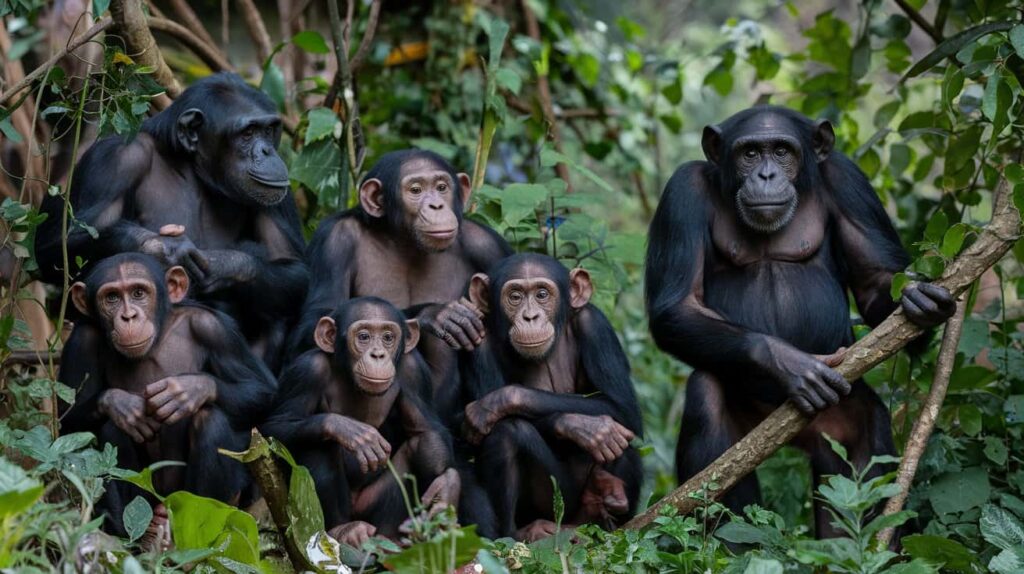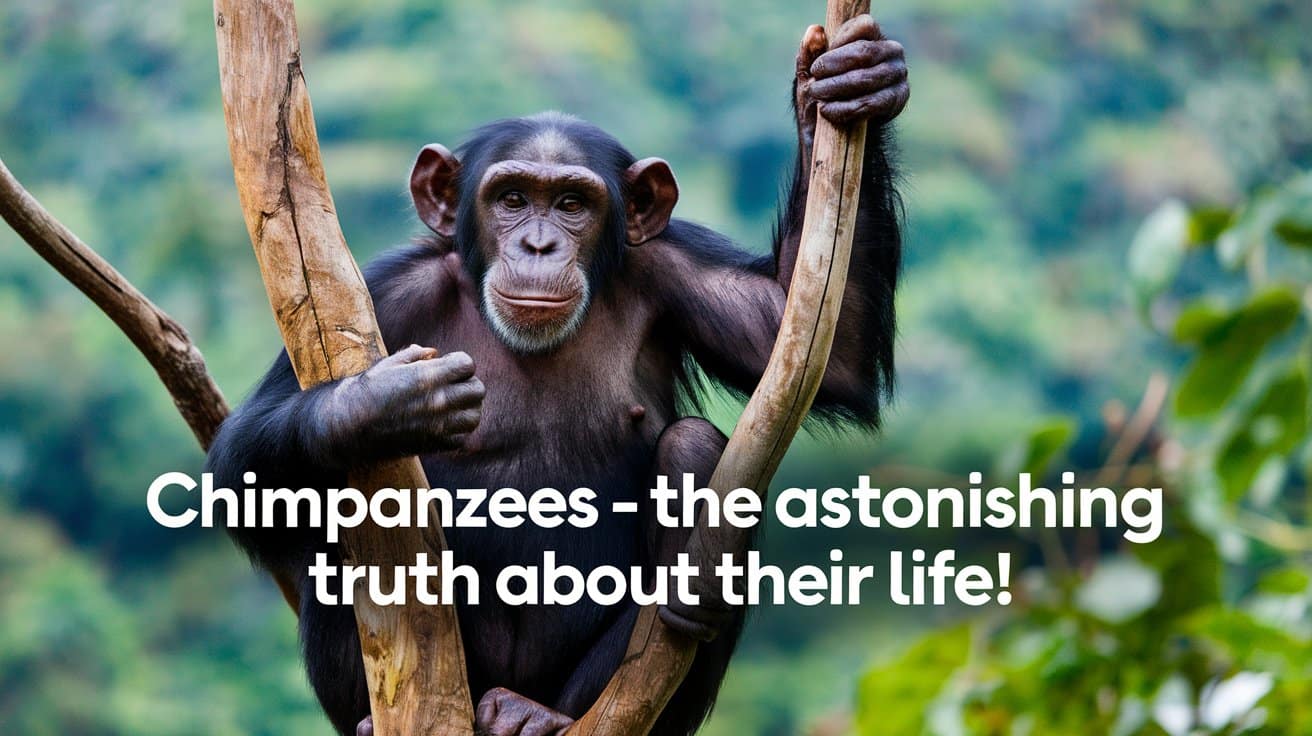Chimpanzees are truly captivating creatures—I still remember the awe I felt during my first encounter at a wildlife reserve. Watching them use tools, communicate, and interact with their group was like glimpsing a mirror of our own behavior.
Chimpanzees are intelligent great apes native to Africa, known for their complex social behaviors and tool use. Sharing about 98% of their DNA with humans, they exhibit remarkable similarities in communication and emotions. Unfortunately, they face threats from habitat loss and poaching.
Stay tuned with us as we dive deeper into the fascinating world of Chimpanzees. We’ll explore their unique behaviors, intelligence, and the challenges they face in the wild. Don’t miss out on learning more about our closest animal relatives.
The Chimpanzee’s Place In The Primate Family Tree – Amazing Facts And Behaviors!
Evolutionary Ties to Humans
Chimpanzees, along with bonobos, are our closest living relatives in the animal kingdom. We share a common ancestor that lived approximately 5-7 million years ago, making them more closely related to us than they are to gorillas or orangutans. This close evolutionary relationship is reflected in our genetic makeup – humans and chimpanzees share about 98-99% of their DNA.
Taxonomic Classification
Chimpanzees belong to the family Hominidae, which includes all great apes: humans, chimpanzees, bonobos, gorillas, and orangutans. The genus Pan encompasses both chimpanzees (Pan troglodytes) and bonobos (Pan paniscus). There are four recognized subspecies of chimpanzees:
- Western chimpanzee (Pan troglodytes verus)
- Nigeria-Cameroon chimpanzee (Pan troglodytes ellioti)
- Central chimpanzee (Pan troglodytes troglodytes)
- Eastern chimpanzee (Pan troglodytes schweinfurthii)
Each subspecies has its own unique range and slight variations in appearance and behavior.
Physical Characteristics – The Chimpanzee Form!
Size and Build
Chimpanzees are robust primates with a distinctive appearance. When standing upright, they typically reach heights of 3 to 5.5 feet (1 to 1.7 meters). Males are generally larger than females, exhibiting a degree of sexual dimorphism common in great apes.
Adult males weigh between 88 and 132 pounds (40 to 60 kilograms), while females range from 60 to 110 pounds (27 to 50 kilograms).
Facial Features and Expressions
One of the most striking aspects of chimpanzees is their expressive faces. Their features are hairless, with skin tones ranging from pink in infancy to dark brown or black in adulthood. Large, forward-facing eyes give them excellent depth perception, crucial for navigating their arboreal habitats.
Their ears are prominent and rounded, similar to human ears but with greater mobility.
Chimpanzees are capable of a wide range of facial expressions, including smiles, frowns, and pouts. These expressions play a vital role in their complex social communications.
Limbs and Locomotion
Chimpanzees have long, powerful arms that are well-adapted for both brachiation (swinging through trees) and knuckle-walking on the ground. Their hands are dexterous, with opposable thumbs that allow for precise manipulation of objects. Their feet are also prehensile, with an opposable big toe that aids in climbing and grasping.
While capable of walking bipedally for short distances, chimpanzees primarily move on all fours using knuckle-walking, where they support their weight on the knuckles of their hands.
Coat and Coloration
A thick coat of coarse black hair covers most of a chimpanzee’s body, providing protection from the elements and minor injuries. The hair on their faces is typically sparse, with males often developing a distinctive white beard as they age. Some individuals, particularly older adults, may exhibit gray or reddish tints in their coat.
Interesting Fact: The ://Vital-Mag.Net Blog – Get The Latest Health & Tech News!
Habitat And Distribution – Where Chimpanzees Call Home!
Geographic Range
Chimpanzees are native to equatorial Africa, with a range that spans approximately 2.6 million square kilometers (1 million square miles). Their distribution extends from Senegal in the west to Tanzania in the east, encompassing a diverse array of habitats across 21 countries.
Preferred Ecosystems
While often associated with dense tropical rainforests, chimpanzees are remarkably adaptable and can thrive in a variety of environments, including:
- Lowland rainforests
- Montane forests
- Swamp forests
- Savanna woodlands
- Grasslands with scattered trees
This adaptability has allowed chimpanzees to occupy a wide range of elevations, from sea level to altitudes of up to 3,000 meters (9,800 feet) in some mountainous regions.
Habitat Requirements
Chimpanzees require habitats that provide adequate food resources, water sources, and suitable nesting sites. Key elements of their ideal habitat include:
- A diverse array of fruit-bearing trees
- Areas with herbaceous vegetation for foraging
- Access to water sources
- Sufficient tree coverage for nesting and shelter
- Connectivity between forest patches to allow for movement and genetic exchange between populations
Chimpanzee Behavior – A Complex Social World!
Social Structure
Chimpanzees live in complex social groups called communities or troops, which can range in size from 20 to over 150 individuals. These communities are characterized by a fission-fusion social structure, where smaller subgroups form and reform within the larger community.
Dominance Hierarchies
Within chimpanzee communities, there are distinct dominance hierarchies among both males and females. Male chimpanzees typically form the core of the community, with a clear alpha male at the top of the hierarchy.
This alpha status is often achieved through a combination of physical strength, social intelligence, and coalition-building with other males.Female chimpanzees also have their own hierarchies, which can influence access to resources and mating opportunities. However, female hierarchies tend to be less rigid and more subtle than those of males.
Communication
Chimpanzees are highly communicative animals, using a variety of vocalizations, facial expressions, body postures, and gestures to convey information. Some key aspects of chimpanzee communication include:
- Vocalizations: Chimpanzees produce a wide range of sounds, from soft grunts and hoots to loud screams and pant-hoots. The pant-hoot is a particularly distinctive call used to communicate over long distances and coordinate group activities.
- Facial expressions: Chimpanzees have highly mobile faces capable of expressing a range of emotions. They use various expressions to convey feelings such as fear, anger, excitement, and contentment.
- Gestures: Chimpanzees use a complex system of hand and body gestures to communicate. These can include pointing, reaching, and even using objects to draw attention to something.
- Touch: Physical contact plays an important role in chimpanzee social bonding. Grooming, embracing, and patting are all used to reinforce social ties and provide comfort.
Tool Use and Problem-Solving
One of the most fascinating aspects of chimpanzee behavior is their advanced cognitive abilities, particularly in the realm of tool use. Chimpanzees are among the most prolific tool users in the animal kingdom, second only to humans. Some examples of chimpanzee tool use include:

- Using stones as hammers to crack open nuts
- Fashioning sticks into spears for hunting small prey
- Creating leaf sponges to collect water from tree hollows
- Using sticks to fish for termites or ants
- Utilizing leaves as napkins or for personal hygiene
This sophisticated tool use demonstrates not only their problem-solving abilities but also their capacity for cultural transmission, as different chimpanzee communities have been observed to have unique tool-using traditions.
Diet And Foraging – The Chimpanzee’s Diverse Palate!
Omnivorous Diet
Chimpanzees are omnivores with a diet that primarily consists of plant matter but also includes meat and insects. Their dietary composition can vary significantly based on habitat, season, and local food availability.
Plant-Based Foods
The majority of a chimpanzee’s diet (up to 60%) consists of fruits. They consume a wide variety of fruit species, with figs being a particular favorite. Other important plant foods include:
- Leaves and shoots
- Flowers
- Bark
- Seeds and nuts
- Pith (the soft inner tissue of plant stems)
Chimpanzees have been observed to consume over 300 different plant species, demonstrating their dietary flexibility and botanical knowledge.
Animal Prey
While primarily frugivorous, chimpanzees are also skilled hunters. They engage in cooperative hunting behaviors to catch and consume various animal prey, including:
- Smaller primates (such as colobus monkeys)
- Bushpigs
- Duikers (small antelopes)
- Birds and their eggs
Hunting behavior can vary between different chimpanzee communities, with some groups hunting more frequently than others.
Insect Consumption
Insects form an important part of the chimpanzee diet, providing essential proteins and fats. Common insect foods include:
- Termites
- Ants
- Bee larvae and honey
Chimpanzees often use tools, such as fishing sticks, to extract insects from their nests or mounds.
Seasonal Variations
The chimpanzee diet can vary significantly with the seasons. During times of fruit scarcity, they may rely more heavily on leaves, bark, and animal foods. This dietary flexibility is crucial for their survival in diverse and changing environments.
Reproduction And Life Cycle – From Infancy To Adulthood!
Mating Behavior
Chimpanzees have a promiscuous mating system, where both males and females may mate with multiple partners. Mating can occur throughout the female’s menstrual cycle, but is most frequent when females are in estrus, signaled by visible genital swellings.
Gestation and Birth
The gestation period for chimpanzees is approximately 8 months. Females typically give birth to a single infant, with twins being rare. Births usually occur at night or in the early morning hours.
Infant Development
Newborn chimpanzees are completely dependent on their mothers for the first few months of life. Key stages in their development include:
- 0-5 months: Infants cling to their mothers constantly
- 5-12 months: Infants begin to explore their surroundings but stay close to their mothers
- 1-3 years: Young chimps become more independent but still nurse and sleep with their mothers
- 3-5 years: Juveniles are weaned but remain close to their mothers, learning crucial survival skills
Adolescence And Adulthood
Chimpanzees reach sexual maturity between 8-10 years of age, but females typically don’t give birth until they are 13-15 years old. Males may not achieve high rank within their community until they are in their twenties.
Lifespan
In the wild, chimpanzees can live up to 50 years, although the average lifespan is closer to 30-40 years. In captivity, they have been known to live into their sixties.
Conservation Status – Protecting Our Primate Cousins!
Current Threats
Chimpanzees face numerous threats in the wild, leading to their classification as Endangered on the IUCN Red List. The primary threats include:
- Habitat loss and fragmentation due to deforestation and agriculture
- Hunting for bushmeat and the illegal pet trade
- Disease transmission from humans (such as respiratory infections)
- Climate change affecting food availability and habitat quality
Conservation Efforts
Numerous organizations and initiatives are working to protect chimpanzees and their habitats. Some key conservation strategies include:
- Establishment and management of protected areas
- Anti-poaching efforts and law enforcement
- Community-based conservation programs
- Reforestation and habitat restoration projects
- Public education and awareness campaigns
The Role of Sanctuaries
Chimpanzee sanctuaries play a crucial role in conservation efforts by:
- Providing care for rescued and orphaned chimpanzees
- Conducting research to improve our understanding of chimpanzee behavior and needs
- Educating the public about chimpanzee conservation
- Supporting local communities through employment and education programs
The Importance Of Chimpanzee Research – You Need To Know!
Insights into Human Evolution
Studying chimpanzees provides valuable insights into human evolution and behavior. By comparing chimpanzee and human traits, researchers can better understand:
- The development of social structures and cooperation
- The evolution of tool use and technology
- The origins of language and communication
- The basis of human cognitive abilities
Medical Research
Chimpanzees share many physiological similarities with humans, making them important subjects for medical research. While the use of chimpanzees in invasive research has been largely phased out for ethical reasons, observational studies of chimpanzees continue to provide valuable information for human health, particularly in areas such as:
- Understanding the progression and transmission of infectious diseases
- Studying the effects of aging on cognition and physiology
- Developing non-invasive medical imaging techniques
Conservation Biology
Research on chimpanzees in their natural habitats is crucial for developing effective conservation strategies. This research helps us understand:
- Chimpanzee habitat requirements and range use
- The impacts of habitat fragmentation and climate change
- The dynamics of disease transmission between humans and chimpanzees
- The effectiveness of various conservation interventions
Conclusion – Our Responsibility To Chimpanzees!
As our closest living relatives, chimpanzees offer us a unique window into our own evolutionary past and the complexities of primate cognition and social behavior. Their remarkable intelligence, emotional depth, and cultural traditions remind us of the thin line that separates humans from other great apes.
Conservation efforts are crucial not only for the survival of chimpanzees but also for maintaining the biodiversity and ecological balance of their habitats. By protecting chimpanzees, we also protect countless other species that share their ecosystems.
FAQs:
What Is The Main Difference Between A Shipanze And A Chimpanzee?
The term “shipanze” is not a scientifically recognized term distinct from “chimpanzee.” It may be used colloquially or in certain contexts to refer to chimpanzees. Scientifically, chimpanzees (Pan troglodytes) are a distinct species of great apes closely related to humans.
Where Can Shipanze Be Found In The Wild?
Shipanze inhabit the tropical forests and savannas across equatorial Africa, ranging from Senegal in the west to northwestern Tanzania in the east.
How Do Shipanze Communicate With Each Other?
Shipanze communicates through vocalizations, facial expressions, and body gestures. They also use grooming as a social tool to strengthen bonds and reduce tension within the group.
Are Shipanze Endangered?
Yes, shipanze are classified as endangered due to threats such as habitat loss, illegal hunting, and disease. Conservation efforts are ongoing to protect their populations.
How Intelligent Are Shipanze?
Shipanze are highly intelligent, capable of using tools, learning sign language, and solving complex problems. Their cognitive abilities are often compared to those of young human children.
What Do Shipanze Eat?
Shipanze are omnivorous, with a diet that includes fruits, leaves, insects, and occasionally small mammals. Their diet varies depending on their habitat and seasonal food availability.




